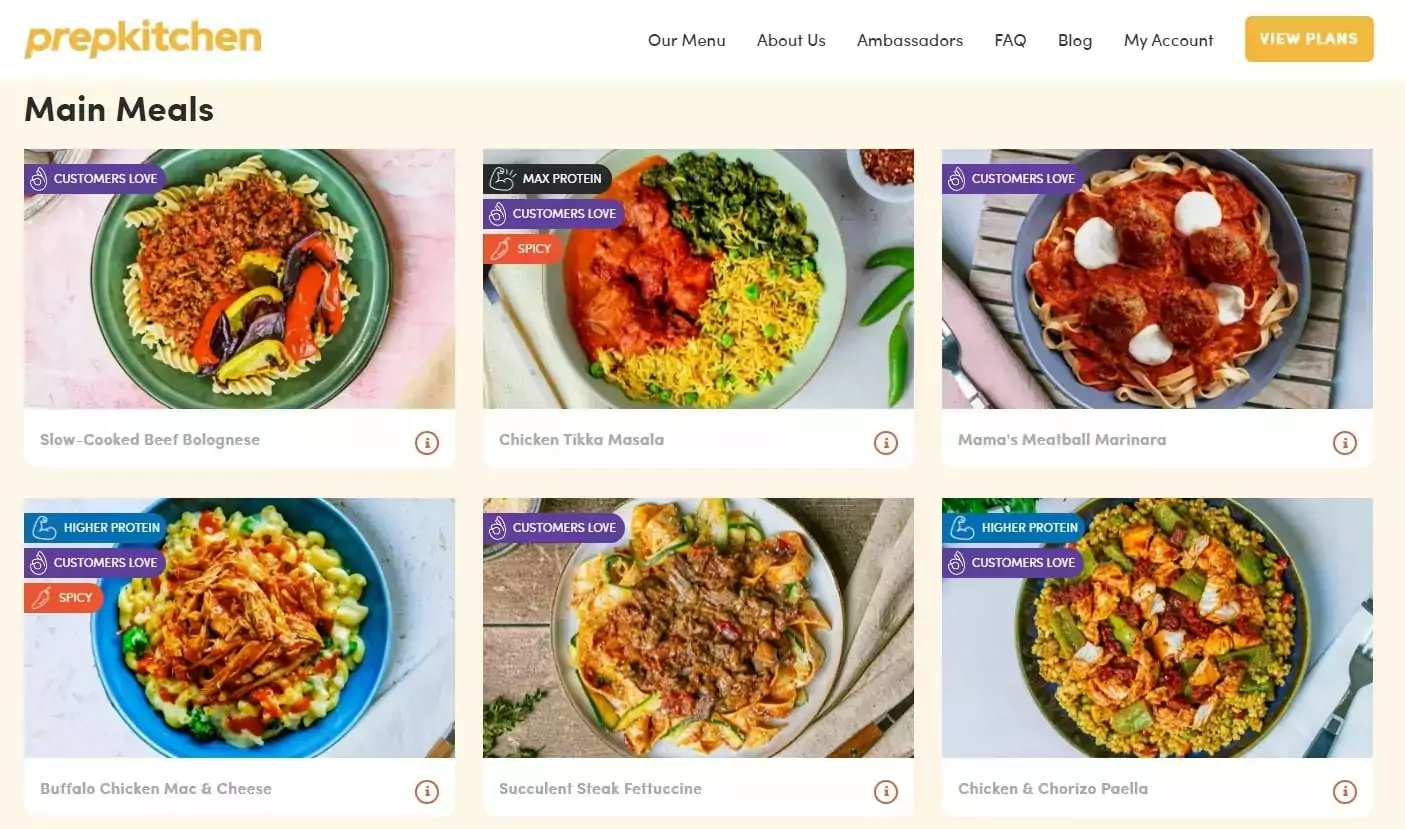Why Start A Subscription Meal Prep Business?
Instead of reordering each week or month, subscriptions enable customers to sign up for automatic renewals, ensuring they receive their meal kits when needed.
It’s ideal for meal prep businesses aiming to provide individuals and families with regularly scheduled deliveries of prepared meal kits.
To set this up, you only need a website and the capacity to produce and deliver meals regularly.
A subscription meal prep business can offer:
- More sales opportunities through an online market
- Convenience for customers
- Regular revenue generation for your meal prep business
- Avoidance of third-party platform fees
- Opportunities for upselling and cross-selling
- Enhanced customer loyalty through personalized subscription options
- Lower costs than a traditional restaurant by running a “cloud kitchen” and reaching a much higher scale
Subscription meal prep challenges
While there are many benefits to running a subscription meal prep business, there are also unique challenges. These include:
No support from food delivery apps: Platforms like Just Eat and Uber Eats don’t offer recurring delivery options, limiting your subscription reach.
Complex logistics: Managing regular deliveries, dietary preferences, and flexible schedules can be difficult without the right systems.
High customer expectations: Subscribers expect reliability, fresh meals, and easy ways to manage their orders or they may cancel.
How to Start a Meal Prep Business Using Subscriptions: 15 Steps to Success
This section explains how to set up a subscription meal prep business from scratch. The first few steps involve deciding the type of business you’ll start and who you’ll serve.
1. Choose your niche
Choosing a niche allows you to focus on a specific customer type, which makes it easier to market your meal prep offerings.
Identify what sets your business apart by considering the following:
Passions and skills: Are you enthusiastic about a particular diet? Sharing your well-researched meal plans could resonate with health-conscious customers.
Community needs: Perhaps you’re part of a Catholic community that eats fish on Fridays instead of meat. Your meal kits could specifically cater to this tradition.
Business opportunity: Maybe you recognize a gap in the market, such as meal kits designed for special occasions like anniversaries or kids’ birthdays.
Dietary needs: Consider catering for specific dietary requirements, such as vegan, keto or gluten-free food.
2. Decide what kind of meal kits you will offer
You have two main options when it comes to starting your meal planning business:
Uncooked meal kits
Here, you will include all the raw ingredients needed for your dish with instructions on how to cook it.
For example, Blue Apron offers spicy BBQ pulled chicken bowls, providing all the ready-to-cook ingredients and steps for preparing them.
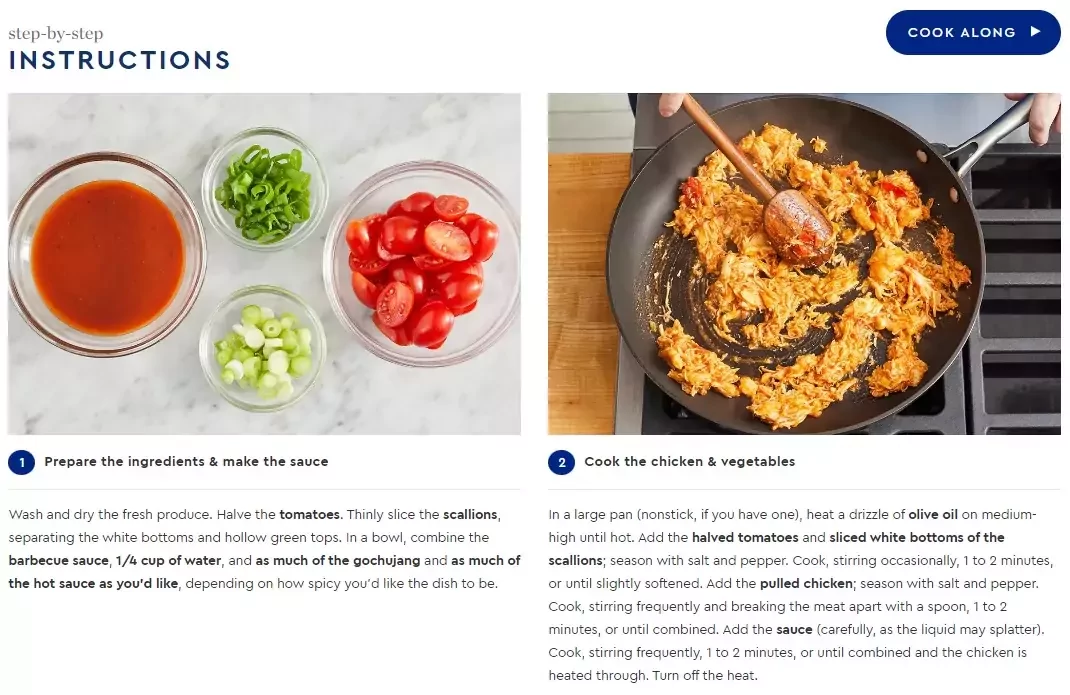
Cooked meal kits
This means that you do all the heavy lifting, such as sourcing ingredients and cooking the meals, and your customers simply heat them when they’re ready.
You could offer a range of pre-cooked meals, such as chicken tikka masala or buffalo chicken mac and cheese, which they can choose from and have delivered to their doorstep.
Customers can store these meals in their fridge or freezer; when they’re ready to eat them, they can heat them in their microwave or oven.
Here are a few popular options for cooked meals:
Whether you offer raw ingredients or pre-cooked meals, ensure your packaging and logistics are designed for safely and efficiently shipping fresh food.
3. Give your meal prep business an identity
Once you know what your meal preparation business is going to sell, you can start creating your unique business identity. This is where branding comes in.
Your name and logo should mirror your unique selling proposition and resonate with your target market.
For instance:
- If you target retirees, opt for a classical branding style.
- If you target students, consider a more trendy approach.
You should also study your competitors’ branding to understand what works and ensure yours stands out.
💻 Need a website?
Subbly has several templates designed for meal kit delivery service websites. You can preview demos of each template instantly, making it easy to choose the one that suits your specialized business.
For example, we’ve got this stunning and functional meal kit delivery template to get your business up and running immediately.
Start here to choose your website.
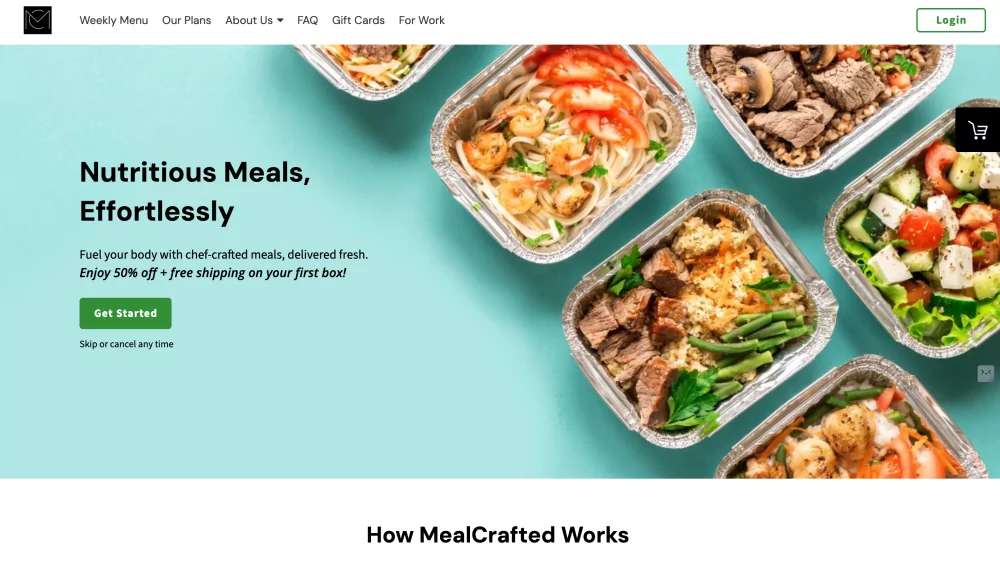
4. Register a suitable business entity
To legally do business, you need to choose a business structure for your meal prep venture and then register it. This involves deciding whether to operate as a sole proprietorship, partnership, or corporation.
Many prepared meal services go with a Limited Liability Company (LLC) because it offers tax advantages and protects you from personal liability. Do some research to make an informed decision.
To register, simply Google “Secretary of State website [state name],” along with the state you plan to operate in to find the correct website:
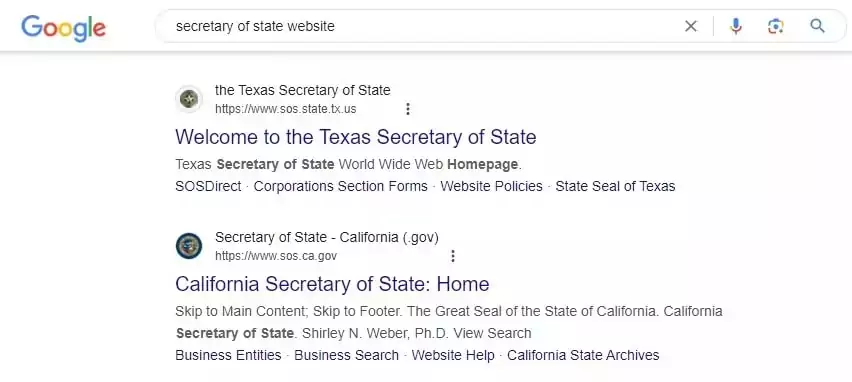
You’ll find clear guidance on what you need to do to make your business entity official.
5. Choose a business model
You have two main meal prep business model options: sell from a physical location or run your business entirely online.
Storefront model
This involves selling your meals from a shop or a stall at a local farmers’ market. It can help build trust with local customers and allows you to offer a personal touch. But overheads are higher, opening hours limit flexibility, and growth is often tied to your location.
Online-only model
Selling through your website means lower startup costs and the ability to reach a wider audience. It’s easier to scale and automate, but you’ll rely more on marketing efforts to get discovered, and you won’t get the same in-person feedback.
Many entrepreneurs start locally to test their concept, then shift online to grow. Others launch entirely online from day one, using tools like Subbly to handle orders, subscriptions, and customer preferences.
6. Find funding to kickstart your meal prep business

Starting a meal prep business typically requires at least $10,000 for equipment, ingredients, packaging, and your website or storefront. There are a few ways to fund it:
Fund your own business
You can withdraw money from your savings or liquidate your investments to kickstart your meal prep business: A strategy often called bootstrapping.
This way, you keep full control over your business without taking on debt or giving up a share of your company. Most importantly, you won’t have to answer to anyone else.
However, the downside is that your funds might be limited, which can make it harder to grow quickly.
There’s also a big personal financial risk involved because you might have to invest a large portion of your savings into your meal prep business, leaving you vulnerable if it doesn’t work out.
Borrow from a lender
If you don’t have enough savings to bootstrap your meal prep delivery business, or you want to keep your personal and business finances separate, then you can borrow money.
There are three main types of credit you can apply for:
Business loans: This is when you borrow a set amount of money that’s immediately transferred to your account, and you slowly pay it back at a set rate each month. Make sure you set out a proper budget for how you will spend your loan, and be mindful of how long you’ll have to continue paying it off.
Business credit cards: These are convenient for covering immediate expenses and often come with rewards or cashback benefits. Credit cards often have the highest interest rates, and you need to be cautious about overspending. Business credit cards may also include a business savings account or a business checking account, which may come with an optional overdraft facility.
Equipment funding: This lets you buy the equipment you need, with the equipment itself serving as collateral. Since lenders have an asset that they can claim if you don’t meet your repayments, the interest rate is often lower and they’re more flexible with repayments.
Overall, using credit to fund your meal prep company can help you start sooner than saving up funds. However, this early access comes at the cost of interest payments.
Before taking this route, make sure you understand all the fees involved and that you can afford the monthly repayments.
💡 Tip: Write a business plan
Before you approach a lender or any other third-party funder, you’ll need a business plan.
A business plan is a written document that outlines your business goals and the strategy for achieving them.
It typically includes:
- An overview of your business: What you do, who you serve, and what makes you different
- Market analysis: Who your competitors are and how you plan to stand out
- Operations plan: How your business will run day to day
- Marketing and sales strategy: How you’ll attract and retain customers
- Financial projections: Expected revenue, costs, and business income over time
- Funding needs: How much capital you need and how you’ll use it
Most banks and funders will require you to submit a food prep business plan before they will consider lending to you. However, it’s a good idea to produce one even if you bootstrap your business, as it will help guide your decision-making.
Secure startup funding
Another option is securing small business funding from venture capitalists or angel investors who believe in your business ideas and decide to invest in it.
You get immediate access to funds, and in return, they get a share of your business. They may also offer you expertise and mentorship, which can significantly boost your business.
However, this type of small business funding often means giving up some control and ownership, potentially leading to conflicts over business decisions.
Get support from entrepreneur organizations
Global organizations such as Good Food Accelerator and Food Innovation Network offer guidance to startup businesses.
Organizations like these can assist you with securing funding, accessing mentorship from meal prep industry experts, and connecting with potential investors.
Their resources and networks can improve your chances of getting the financial backing you need to grow your meal prep business.
7. Get access to a kitchen (if required)
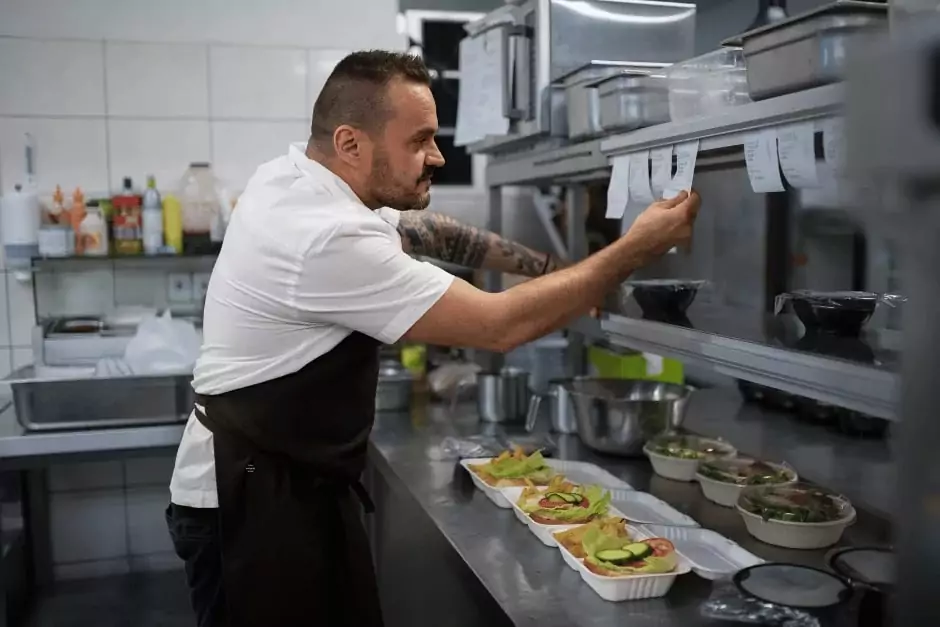
To prep and pack your meals, you’ll need the right space. Many new businesses start small and scale up as demand grows.
Start at home: If local laws allow, preparing meals from your home kitchen can keep costs low early on. Just be sure to check health and zoning regulations.
Move to a shared kitchen: As orders increase, consider renting space in a commercial kitchen or partnering with a local restaurant during off-hours. This gives you access to better equipment without the cost of your own facility.
Upgrade to your own space: Once you’re ready to scale, a dedicated commercial kitchen will give you full control over operations.
You may also want to consider incubator kitchens. These offer all-in-one access to commercial facilities, mentoring, and support for food entrepreneurs.
An example is the Incubator Kitchen Collective, which supports meal prep entrepreneurs in Northern Kentucky.
8. Choose Your Suppliers

Once you know where you will work, it’s time to gather all the ingredients and packaging materials for your meal prep kits.
Bad suppliers can cause delays, poor food quality, and unhappy customers, which can hurt your business.
When selecting suppliers for fresh food, packaging, and equipment, keep the following in mind:
Reliability and consistency: Choose suppliers known for their reliability and consistent delivery schedules to avoid disruptions in your process.
Cost-effectiveness: Compare prices from different suppliers to ensure you’re getting the best value without compromising quality.
Eco-friendliness: Consider eco-friendly packaging options to appeal to environmentally conscious customers.
Compliance: Ensure the packaging complies with local health and safety regulations to keep your business in good standing.
Quality and durability: Invest in high-quality, durable equipment that can withstand the demands of your meal prep business operations.
With the best suppliers on standby, your meal prep business will consistently deliver top-quality food to your customers.
9. Choose a Delivery Method

Deciding how to get the food to your customers is one of the most important decisions you will make. Here are some options to consider:
- Sell your meals through an app that offers food delivery, like Deliveroo or Uber Eats.
- Hire your own delivery drivers.
- Use a driver agency like GigSmart
- Deliver via a national courier like UPS
- Require customers to come to you
- Do it yourself
All of these have pros and cons and will suit different businesses.
It’s important to do your research to ensure whoever delivers your meals can keep them protected and at the correct temperature.
10. Get the right permits and licenses

Running a business means meeting regulatory requirements. Here’s what you need to focus on:
Food business licenses
Every state has different requirements for food businesses, so you need to research the regulations where you plan to operate.
For example, California’s Cottage Food Law allows individuals to prepare and sell certain low-risk foods from a home kitchen.
To comply, you need to register your business entity with your local health department, complete a food safety training course, and ensure your kitchen meets specific health and food safety standards.
In New York, you need a Home Processor Exemption, which requires you to adhere to specific food labeling guidelines and pass a home kitchen inspection.
Make sure you understand and follow the regulations in your state. This will ensure legal protection for your business and keep it running smoothly.
General business licenses
You’ll also need to obtain business licenses to run a company. This will depend on several factors but could include:
- Business license
- Employer Identification Number (EIN)
- Seller’s permit
Environmental health licences
Food-handling businesses need to meet certain health and safety standards to protect customers and employees from unsafe or unhealthy conditions or situations.
Required licenses could include:
- Local health department approval
- Employee health permit
- Business health permit
11. Get the Right Business Insurance
You also need to protect your business against risks.
What happens to your business if it gets sued for food poisoning or transferring allergens to customers?
Without the right business insurance, a lawsuit can ruin your company financially. That’s why you need to take out cover for your company.
General liability insurance protects you against claims of bodily injury and property damage, while product liability insurance specifically covers you for issues related to the food you sell.
These are examples of the kinds of insurance that you need to look into as a food entrepreneur.
On top of this, you should also consider the following:
Commercial property insurance: Covers damage to your business property, including your kitchen equipment and incoming and outgoing supplies.
Commercial auto insurance: If you use a vehicle for meal deliveries, this covers accidents and damages related to business use.
Workers’ compensation insurance: This is required if you have employees. It covers medical expenses and lost wages for workers who get injured on the job.
When choosing insurance, carefully consider your needs, shop around, and get several quotes before selecting a provider and insurance plan.
12. Design your menu
Now comes the fun part: Designing the delicious meals you’ll sell. You’ll need to consider meals that enable you to provide consistent quality, nutritional value, and variety that keep customers coming back.
Here are some things to consider:
Develop recipes for scale: Home cooking is different from commercial meal prep. Your recipes need to be scalable, meaning they can be consistently replicated in larger batches without losing quality or flavor.
Standardized recipes: Create detailed, step-by-step recipes with precise ingredient measurements and cooking instructions. This ensures consistency regardless of who is preparing the meal.
Yield and portion control: Accurately determine the yield of each recipe and standardize portion sizes. This is vital for cost control, consistent customer experience, and accurate nutritional information.
Food costing: Before finalizing any recipe, calculate its per-portion food cost. This will directly impact your pricing strategy and profitability. Always factor in ingredient waste and spoilage.
Rotating menus: Most successful meal prep businesses use a rotating menu (e.g., weekly or bi-weekly cycles). This keeps things interesting for customers and gives you time to stock up on stock you’ll need for the next rotation.
13. Set Your Pricing Strategy

Now that your business is legally compliant, insured, and ready to operate, it’s time to determine your pricing strategy.
While setting prices may seem straightforward, it requires thorough research and thoughtful consideration.
Simply picking a number won’t suffice; you need to find a balance that attracts customers while ensuring profitability.
When making this decision, ask yourself these questions:
What profit margin do you need to sustain and grow your business? This is the amount of profit you must aim for to keep your business profitable and have the financial capacity to expand.
What are the total costs for each meal kit? Calculate all expenses in preparing your meal kits, and add the desired profit margin to see how much you need to charge per meal to ensure profitability.
How does your pricing compare with competitors in the market? Research what successful meal prep businesses charge and evaluate how your meal prep delivery services compare regarding quality and convenience. If you plan to charge more than they do, make sure you can justify putting this cost on your customers.
Is your pricing affordable for your target market? Understand how much your customers are willing and able to spend. Adjust your prices to fit their budgets, especially if you’re targeting specific groups like students.
By answering these questions, you can set a pricing strategy that covers your costs and profit goals while meeting your customers’ expectations.
14. Choose a meal-prep-focused subscription ecommerce platform
Before you can start selling online, you’ll need an ecommerce platform to build your website.
At the very least, it should let you take payments, manage orders, and track inventory.
However, the challenge comes if you want to sell meals on a subscription basis. You’ll need tools for recurring billing, flexible scheduling, and customer self-service.
Most platforms like Shopify or WooCommerce weren’t built with subscriptions in mind. Instead, you have bolt-on third-party plugins to enable these features.
These apps don’t integrate well and can cause errors, which can mean more work for you, poor customer service, and difficulties scaling your meal prep business.
That’s why it’s worth choosing a platform built for subscriptions like Subbly.
It enables you to build your site, set up flexible subscription plans, and manage everything from one place. Customers can pause or skip a week, change their delivery day, or swap meals, without needing to email you every time.
It’s simple, smooth, and designed to grow with your business.
😄 See for yourself: Sign up for a free trial of Subbly today.
🔍 Check out our case studies
Food subscription services around the world have seen success using Subbly. Check out our customer stories for:

15. Market Your Business
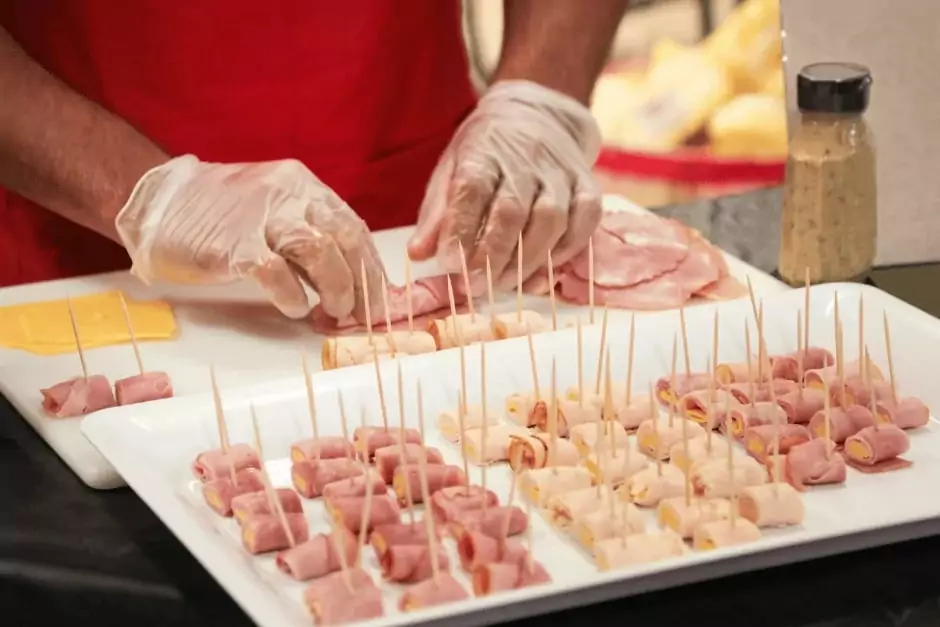
Simply starting a business won’t guarantee customers. You need to make people aware of your business and tell them how your delicious meals will enrich their lives.
To achieve this, you need a kickass marketing plan that effectively communicates your value proposition.
There are three ways to approach this:
- Do it yourself: You can research marketing tactics for a meal prep company and do your best to implement the suggestions yourself. This is the most cost-effective option and allows you to have full control over your marketing strategies and messaging. However, it requires significant time to learn and execute it effectively.
- Hire freelancers: You could onboard a freelancer who specializes in your preferred marketing channel, such as social media marketing or pay-per-click advertising. Freelancers are a cost-effective option, but they may not uphold the same standards as agencies, potentially compromising on quality.
- Hire an agency: Lastly, you could hand this task over to an experienced agency. This is the most expensive choice, but you will get a full marketing plan, a high standard of work and your meal prep company will be seen by many potential customers.
Your marketing strategy should be clearly outlined in your meal prep business plan, so try to have this sorted out before you launch.
Invest in good photography
While doing your own marketing is commendable, hiring a professional food photographer can significantly boost your efforts.
In the food industry, visual appeal is everything, and subpar or average photographs can cost you new customers.
Food photography is more complex than it may seem at first glance, often involving advanced techniques that go beyond simply taking pictures of food.
It also requires specialized equipment, such as additional lighting, reflectors, backdrops, and sometimes even props to enhance the presentation of the food.
Check out this video to learn more about the unbelievable tricks photographers use to make food look delicious.
How to get them hooked
A great strategy for meal kits is to offer free samples that will allow your customers to see firsthand how wonderful your service is.
For example, if you have weekly fresh food meal kits delivered to health-conscious customers, offer them “Free Meatless Mondays” for their first three months to help them convert more easily.
Use social media
When you start out, no one will have heard of you. So, how can you get your first few sales?
Family and friends are the best place to start, but you can’t rely on them forever.
Social media platforms are one of the most affordable and effective ways to market a new meal prep business.
Here’s why:
- Precisely target your ideal customers by interest, area, age and more.
- Show them mouth-watering images of your dishes.
- Allow customers to follow your brand so you can engage with them more in future.
It’s important to consider what social media platforms your target customers use the most.
For example, if your target market is older customers then Facebook is a good idea, while Instagram and TikTok might be better for a younger target audience.
Get Your Meal Prep Subscription Business Sizzling with Subbly

Starting your meal delivery business isn’t easy, but the right tools can make it easier to launch and run your venture.
That’s where Subbly’s all-in-one subscription ecommerce platform comes in. It allows you to build a professional website, take advantage of recurring revenue opportunities, and ensure high customer satisfaction.
We even have specialized bundles for meal prep businesses that encourage customers to increase their baskets with strategically placed discounts. See what this looks like here.
Contact us today for a free trial and see whether it’s the right fit for your venture.


